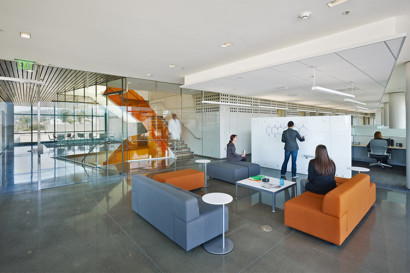AIA design awards go to residence commons, three other buildings
The AIA East Bay has awarded the Berkeley’s Maximino Martinez Commons a prestigious Merit Award for design and sustainability. Citation Awards went to two other campus buildings — the Energy Biosciences Building and an addition to the College of Environmental Design's Wurster Hall — and Berkeley Lab's solar energy research center, Chu Hall.
October 9, 2015
The AIA East Bay — the local chapter of the American Institute of Architects — has awarded the UC Berkeley’s Maximino Martinez Commons a prestigious Merit Award for design and sustainability.
The six-story student-housing facility, which opened in 2012, is home to more than 400 sophomores and upper-division students. Located at 2520 Channing Way, Martinez Commons is built to LEED Gold sustainability standards, with low-flow toilets and showerheads, solar-heated water and storage for some 80 bicycles among its low-impact features. Three of the furnished apartments are designed for the hearing-impaired.
The commons is named in memory of Max Martinez, a longtime and beloved Berkeley staff member, who dedicated his career to helping students, particularly the underprivileged.
Three other buildings on campus and at Berkeley Lab received AIA East Bay Citation Awards.
The Energy Biosciences Building, which made its debut in 2012, is a state-of-the-art research facility for the Energy Biosciences Institute, an interdisciplinary research organization of more than 300 scientists working to solve global energy challenges and mitigate climate change.
The building, built to LEED Gold standards, has office spaces and laboratories for teams dispersed throughout areas including greenhouses, warm and cold rooms, and molecular biology labs.
The architectural shop in Wurster Hall expanded for use as a digital fabrication lab for College of Environmental Design students and faculty.
The addition uses the footprint and existing concrete walls of a 1,500-square-foot courtyard next to the fabrication shop.
The building has been the home to environmental design students since 1964, and was built in the Brutalist style of the 1950s to the mid-1970s, known for its fortress-like concrete construction. The addition’s architects took care to respect the building’s origins.
Lawrence Berkeley National Laboratory‘s Chu Hall — the solar energy research center — also got a Citation Award for its remarkable design. In designing the site for the alternative energy research facility, architects had to adhere to stringent vibration and light requirements on a small site within a compact core of interactive research facilities, on a sloping hillside.
Renewable and recycled materials were incorporated throughout. The building has a green roof and open plaza that serves as a connection to nearby buildings. Plantings were to be drought resistant and native.
The American Institute of Architects East Bay Design Awards program recognizes design excellence in architecture, residential architecture, interior architecture, restoration and renovation, and urban design. The awards are given for quality of design, resolution of the program idea, sustainable responsibility, innovation, thoughtfulness and technique.
See a full list of the 2015 AIA East Bay award recipients, including the projects’ architects, general contractors and project management organizations, at the institute’s website.



